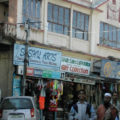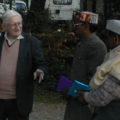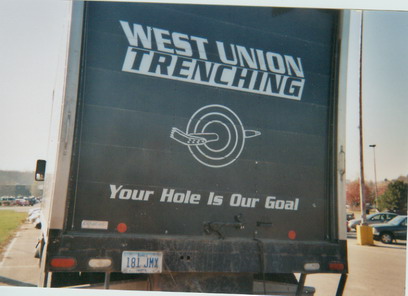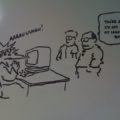Funny Sign: Your Hole…
Everyone who steals this picture can thank my mom, who took it!
Bormio: An Ancient Hot-Spring Spa in the Italian Alps
We took a family mini-vacation to Bormio again. This time we stayed at the hotel of the Bagni Vecchi (old baths), whose price includes unlimited admission to the spa, and breakfast and dinner.
above: View from the window of the hotel restaurant
Tourist information for Bormio

^ Ceiling decoration of a pharmacy built in 1555
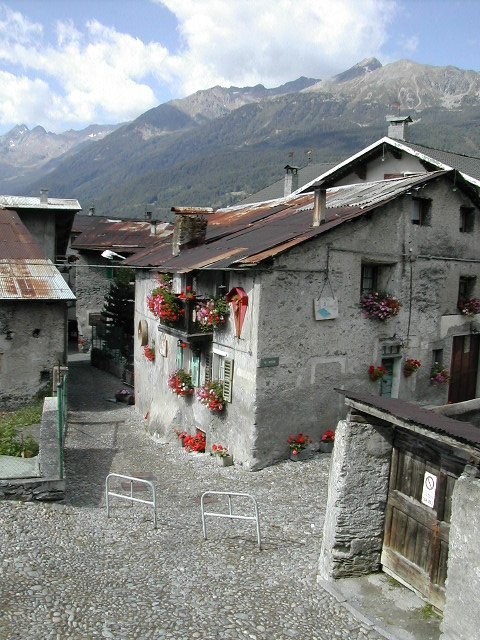
^ Bormio is a typically beautiful Alpine town, with ancient stone houses, their gray exteriors enlivened by bright flowers
Fun with Multimedia
Now that my MBA course is over and I can, without guilt, dedicate my time to non-studying activities, I’ve thrown myself into a couple of multimedia projects which had been on the back burner for some time.
One is a yearbook CD for my daughter’s middle school class. I did one last year almost by accident. During the class plays I sat in the front row videotaping for posterity (and for my husband, who couldn’t be there). Several parents asked if I could make copies of the videotape for them, but tape would have been a major pain in the butt. So I digitized the video using the old FutureTel gizmo (sold years ago by Adaptec as VideOh!) and its included software. Not great quality, but good enough for a small window on screen.
I had originally intended to just throw the raw video onto a CD and make copies of that. But then my creative juices started flowing. I already had Illuminatus Opus, a fun and powerful (and cheap!) software which can be used to create self-running, royalty-free multimedia applications. So, many hours of work later, the class yeardisc included a page for each student with photographs and answers to a questionnaire (favorite food, singer, etc.). As each page opened, the application would automatically play a song which Ross and I had chosen to represent that kid. There were pages on the teachers, the class trip and other activities. Each theatre piece had its own page with the video window and still pictures; there was even footage from backstage and the audience.
I made a copy for each student, with a personalized label, and Ross gave them out on the last day of school. We came home that night to phone messages of awed thanks from the kids and their parents: “This is a unique memento which will last forever!”
This year, of course, it’s taken for granted that I’ll do it again. Fortunately, Ross has gotten interested in Opus and is having great fun laying out the pages herself. We’re using one of Opus’ included background templates with bright, jazzy colors, and we’ve conquered the use of transparency to get interesting effects when laying photos over them. This year the classmates are supplying their own photos, and we have many more shots from class trips and other activities. Ross and I still reserve the right to choose a song for each – that was the fun part.
I’m doing something similar for my own high school class, the Woodstock Class of ’81. I have tons of material for this, since I was an avid photographer during high school, have been class secretary for the last 15 years, and I’ve kept things like old school newspapers. A few classmates have also supplied photos; it’s interesting to revisit our school days from someone else’s point of view, with totally different sets of people represented. One of my classmates is a designer and he’s doing the graphic design for the disc. Tracking down the music we used to listen to is both fun and scary. That was the age of disco: Abba, Boney M, the BeeGees… good lord, we actually listened to this stuff? Daily?
I’m having so much fun that I’m beginning to wonder if there’s a way to make a living doing this kind of thing. The music would be a problem: if I was actually being paid for these projects, I’d have to find a way to include popular music without incurring the wrath of the RIAA.
Movie Review: Lagaan
It was easy this year, as usual, to overlook the Oscar nominees in the Best Foreign Language Film category. If you did, you will have missed a great movie, Lagaan, (Amazon UK| US) India’s nominee.Set in British-ruled India in 1893, it’s the story of a village oppressed by heavy taxation (“lagaan”). The local hero rashly accepts a bet with the British army captain that the villagers can beat the Brits at cricket, a game the villagers know little about. (The bet is set off by the villagers’ disparaging remark about grownup British men so intent on a game “just like gilli-danda, which we played as children.”) If the villagers win, they will pay no taxes for three years. If they lose, they must pay triple the usual tax – and they’re already facing hard times due to drought.
The story is predictable and formulaic, with the British captain cartoonishly evil and the village improbably clean – those starving villagers seem to have quite a few changes of clothing! But who cares? It’s tremendously fun, especially the songs and dances. And it’s much more realistic than many Bollywood films: the young lovers, while singing and dancing, are not miraculously transported to the Himalayas, the tulip fields of Holland, or any other scenic locations meant to illustrate the height, depth, and intensity of their feelings.
The score by A.R. Rehman, a lush blend of western and Indian musical styles, is the most exciting film music I’ve heard in years; I wish A.R. would move to Hollywood and take over from John Williams. (Sadly, the full score doesn’t seem to be available on CD, only a collection of the songs.)
The film naturally climaxes in a three-day cricket match. Unfortunately, cricket has in the meantime become India’s national game, and the screenwriter assumes an understanding of it that I never achieved in five years of living in India, so some of the dramatic tension drained away as I puzzled about wickets, runs, and overs. But of course the home team does win, the local British regiment is dissolved, and the villagers deliriously celebrate as the long-awaited rain finally washes down.


